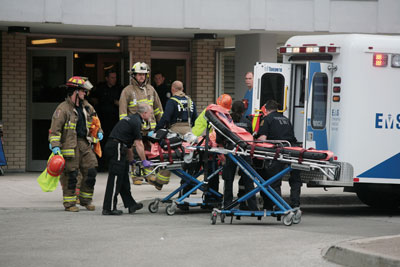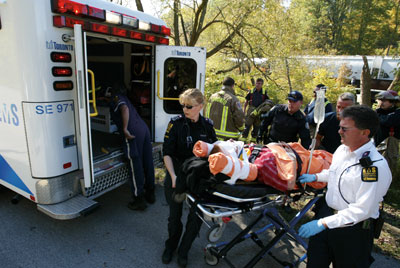
Features
Fire & EMS
Hot topics
The politics of fire/EMS
In recent years, there has been a lot of discussion about the role of the fire department in pre-hospital care.
April 23, 2013
By Rob Grimwood
In recent years, there has been a lot of discussion about the role of the fire department in pre-hospital care. Although responding to medical emergencies is nothing new to the fire service, in Ontario the formalizing of this service through tiered-response agreements was put into place in the mid-1990s in advance of the Ontario Pre-hospital Advanced Life Support (OPALS) study. In the early days of tiered response, the focus of the program was solely on the patients and how best to provide quick and effective response. In many jurisdictions, the firefighters accepted this newly expanded role with reluctance, not entirely sure of the potential benefits of the program and somewhat unsure of their roles in the system.
 |
|
| Firefighters and paramedics are expected to work closely together in tight quarters, stressful circumstances and under demanding timelines, yet they seldom (if ever) have any opportunity to practise working together as a team. Photos by John Riddell
|
In the 20-plus years during which Ontario fire departments have been providing formal tiered response, the entire EMS system has undergone significant change. In that time, responsibility for ambulance service has been downloaded by the province to upper- and single-tier municipalities, thousands of advanced-care paramedics have been trained, the training and responsibility of primary-care paramedics have been significantly expanded, and municipalities have improved EMS services by adding more resources. Also in that time, fire departments have continued to provide tiered response to EMS calls in accordance with their local agreements.
Interestingly, in recent years, the focus discussion has fundamentally shifted to the ownership of these calls and whether (or when) the fire department should respond. This focus on ownership is completely different from the initial discussions that dominated the early days of tiered response, when the issue was what training firefighters should receive, what equipment they should carry, and how they could best be used to benefit the patient.
It is my opinion that, in recent years, we have got too far away from discussing the operations of tiered response and spent too much time lobbying the political structure of the program. In my experience, as both a firefighter and a paramedic, I still frequently notice too many operational gaps. The firefighters and paramedics both respond to calls with the best intentions and the patient in mind, but too often it continues to be a response from two completely separate teams. These two teams are expected to work closely together in tight quarters, stressful circumstances and under demanding timelines, yet they seldom (if ever) have any opportunity to practise working together as a team.
I have witnessed hundreds of calls at which firefighters and paramedics are working toward a common goal but have little or no understanding of each other’s training, equipment, skills or protocols. Even more damaging, I have witnessed dozens of calls at which it is clear that this lack of teamwork creates significant confusion or dissention at the scene. This typically happens when firefighters and paramedics are not clear on each other’s roles and poor communication quickly leads to conflict. Unfortunately, there has been a great deal of effort recently by both fire and EMS lobbying government on the importance of tiered response programs and arguing about the “ownership” of these calls, but how much effort is being put forth to ensure that the programs actually work?
One would think the knowledge that medical calls make up between 40 per cent and 60 per cent of a typical fire department’s call volume, and that the fire department is tiered to between 10 and 20 per cent of an EMS service’s calls, would lead both agencies to make the management of tiered-response programs a bigger priority.
In my department, there has been a concerted effort to ensure that the tiered-response program the public receives is the focus of ongoing planning and development. The first step taken was to very clearly identify which calls warranted fire department tiered response. This was accomplished by conducting a six-month trial during which all tiered response call data was tracked.
The data that was collected included:
- the call type;
- the time the 911 call was received at the ambulance dispatch centre;
- the time the call was received at the fire dispatch centre (and therefore the time it took to transfer the calls between dispatch centres);
- the ambulance response time;
- the fire department response time;
- what care the fire department provided (when it arrived first);
- and a review of the ambulance call report to determine the patient outcome and attempt to quantify the benefit of having the fire department on the call.
The six-month data was evaluated in an effort to determine which emergency medical calls would benefit from fire-department response. While there are people who would advocate sending the fire department to all ambulance calls that are prioritized as emergencies, the vast majority of these calls are not actually life-threatening emergencies and fire-department response is not required. It is worth the effort for each program to determine which calls actually warrant tiered response, as sending extra resources to calls that do not require them is not an effective or efficient use of resources and can actually harm the effectiveness of managing calls by sending too many emergency responders to a call.
The result of our data analysis was the determination that it was beneficial to automatically tier the fire department to all cardiac-arrest calls but not to tier fire to other selected calls (unconscious patients, cardiac chest pain, difficulty breathing) unless the ambulance was delayed for longer than 12 minutes. This is fairly similar to how other tiered-response systems are set up, but other systems seem to set the ambulance delay criteria (five minutes, eight minutes, 10 minutes, etc.) without any evidence to indicate which delay parameter is the most effective. Implementing a system without analyzing the effectiveness of the response often results in a system in which the fire department regularly arrives after the ambulance and is of little value on the call. By taking the time to measure response times and set the proper delay criteria, the instances of the fire department arriving after the ambulance are significantly reduced or eliminated. This will pay immediate dividends as responding firefighters will no longer face so many “cleared by ambulance on arrival” calls.
Once the data analysis was completed and the tiered-response criteria changed to an evidence-based model, my department then developed a tiered-response committee consisting of firefighters and paramedics (and fire and EMS management supervisors). Being a single-tier municipality in which fire and EMS are under one chief, this was easier logistically than it would have been in tiered municipalities, but I would encourage other areas to consider this as an option as its benefits are worth the logistical challenges.
 |
|
| Fire and EMS providers should make management of tiered response a bigger priority and implement programs that will help both agencies provide top-notch patient care.
|
The purpose of the tiered-response committee is to bring firefighters and paramedics to the same table to discuss the training and equipment the firefighters have (or need), discuss the operations of the program (assess how things are functioning at calls), plan joint training opportunities, and debrief and resolve any issues that occur at calls. This committee provides all firefighters and paramedics with a means to resolve any issues that occur, which is of great benefit. In many areas of Ontario, unresolved issues continue to linger and threaten to harm the relationship between firefighters and paramedics because there is no formal means to discuss them. As with most issues, effective communication is the key to success and the formation of a joint committee will achieve this objective.
It is important for the committee to develop tiered-response program policies that provide clarity to firefighters and paramedics about each other’s role and function at tiered-response calls. The next step should be to re-evaluate the patient-care training that firefighters receive and the patient-care equipment that they carry. There are several options for firefighter patient-care training, ranging from basic first aid through emergency first responder. This training can be done by outside agencies or in-house instructors. It is important that each fire department evaluate its own needs and determine what level of training is appropriate. Evaluating the number of medical calls to which a fire department responds, and how often it arrives first, and discussing these calls at a joint fire/EMS tiered-response committee, will likely make it fairly clear what level of training is most appropriate.
Most importantly, selecting the level of training must be done properly – in accordance with certification guidelines – and it must be maintained. Once a level of training is determined, the patient-care equipment should be evaluated to ensure that the firefighters have all of the equipment they are expected to use and, conversely, that they are not carrying equipment they are not properly trained to use.
Some of the other key tiered-response planning and development initiatives my department has found successful include:
- Firefighter ride-outs Firefighters provide patient care while awaiting the arrival of paramedics, assist paramedics with patient care once they arrive and are sometimes expected to accompany paramedics to the hospital in the ambulance. While the first role (providing care while awaiting paramedics) can be practised during regular training, the next two (assisting paramedics with care and accompanying them to hospital) are difficult to simulate. It is for this reason there is so much value in inviting firefighters to participate in ride-along shifts where they ride third with a crew of paramedics. There is great value in this program as it allows firefighters and paramedics to become familiar and comfortable with each other, allows firefighters to become comfortable with the paramedics’ equipment and protocols and exposes the firefighters to more medical calls and patient care than they may regularly get.
- Ambulance visits Similar to the firefighter ride-outs, having a program where paramedics and an ambulance are available to attend the fire stations for training is of great value. This exposes the firefighters and paramedics to each other outside of being on calls and makes them more comfortable working together. Functionally, this also serves as an excellent method of familiarizing firefighters with paramedic equipment and the layout of the ambulance.
- Joint training Another way to improve the working relationship and communication between firefighters and paramedics is to encourage joint training whenever possible. Some examples of this that have been successful in my department have been including firefighters in EMS multi-casualty incident training, including paramedics in fire department auto extrication training and including both firefighters and paramedics in critical incident stress management training (and the formation of a CISM peer support team).
Whether your department is a large urban fire department with full-time firefighters and the potential of running thousands of medical assistance calls, or a small, rural fire department that would only occasionally back up the ambulance, it is important to have an effective tiered-response program. Unfortunately, the recent focus has been too much about the ownership of medical emergencies and not enough about how to effectively develop a tiered response program and effectively deliver this important service to the public.
Rob Grimwood is the manager of emergency services/fire chief for Haldimald County, Ont. Prior to coming to Haldimand County, Rob was a firefighter with the Toronto Fire Services, a volunteer firefighter/officer with the Niagara-on-the-Lake Fire Department, and a paramedic with the Regional Municipality of Niagara. Contact him at rgrimwood@haldimandcounty.on.ca
Print this page